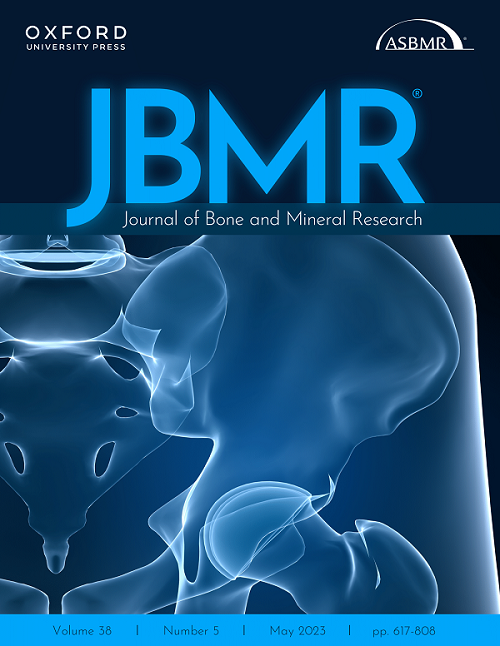Hirotaka Komaba, Junhui Zhao, Angelo Karaboyas, Suguru Yamamoto, Indranil Dasgupta, Mohamed Hassan, Li Zuo, Anders Christensson, Christian Combe, Bruce M. Robinson, Masafumi Fukagawa
求助PDF
{"title":"血液透析患者中活性维生素D的使用与骨折:国际DOPPS的结果。","authors":"Hirotaka Komaba, Junhui Zhao, Angelo Karaboyas, Suguru Yamamoto, Indranil Dasgupta, Mohamed Hassan, Li Zuo, Anders Christensson, Christian Combe, Bruce M. Robinson, Masafumi Fukagawa","doi":"10.1002/jbmr.4913","DOIUrl":null,"url":null,"abstract":"<div>\n \n <p>Active vitamin D is commonly used to control secondary hyperparathyroidism in dialysis patients, but it is unknown whether active vitamin D directly improves bone strength, independently of its ability to suppress parathyroid hormone (PTH). We analyzed the association between the prescription of active vitamin D and incidence of any fracture and hip fracture in 41,677 in-center hemodialysis patients from 21 countries in phases 3 to 6 (2005 to 2018) of the Dialysis Outcomes and Practice Patterns Study (DOPPS). We used Cox regression, adjusted for PTH and other potential confounders, and used a per-protocol approach to censor patients at treatment switch during follow-up. We also used a facility preference approach to minimize confounding by indication. Overall, 55% of patients were prescribed active vitamin D at study enrollment. Event rates (per patient-year) were 0.024 for any fracture and 0.010 for hip fracture. The adjusted hazard ratio (95% confidence interval) comparing patients prescribed versus not prescribed active vitamin D was 1.02 (0.90 to 1.17) for any fracture and 1.00 (0.81 to 1.23) for hip fracture. In the facility preference approach, there was no difference in fracture rate between facilities with higher versus lower active vitamin D prescriptions. Thus, our results do not suggest a PTH-independent benefit of active vitamin D in fracture prevention and support the current KDIGO guideline suggesting the use of active vitamin D only in subjects with elevated or rising PTH. Further research is needed to determine the role of active vitamin D beyond PTH control. © 2023 American Society for Bone and Mineral Research (ASBMR).</p>\n </div>","PeriodicalId":185,"journal":{"name":"Journal of Bone and Mineral Research","volume":"38 11","pages":"1577-1585"},"PeriodicalIF":5.9000,"publicationDate":"2023-09-17","publicationTypes":"Journal Article","fieldsOfStudy":null,"isOpenAccess":false,"openAccessPdf":"","citationCount":"1","resultStr":"{\"title\":\"Active Vitamin D Use and Fractures in Hemodialysis Patients: Results from the International DOPPS\",\"authors\":\"Hirotaka Komaba, Junhui Zhao, Angelo Karaboyas, Suguru Yamamoto, Indranil Dasgupta, Mohamed Hassan, Li Zuo, Anders Christensson, Christian Combe, Bruce M. Robinson, Masafumi Fukagawa\",\"doi\":\"10.1002/jbmr.4913\",\"DOIUrl\":null,\"url\":null,\"abstract\":\"<div>\\n \\n <p>Active vitamin D is commonly used to control secondary hyperparathyroidism in dialysis patients, but it is unknown whether active vitamin D directly improves bone strength, independently of its ability to suppress parathyroid hormone (PTH). We analyzed the association between the prescription of active vitamin D and incidence of any fracture and hip fracture in 41,677 in-center hemodialysis patients from 21 countries in phases 3 to 6 (2005 to 2018) of the Dialysis Outcomes and Practice Patterns Study (DOPPS). We used Cox regression, adjusted for PTH and other potential confounders, and used a per-protocol approach to censor patients at treatment switch during follow-up. We also used a facility preference approach to minimize confounding by indication. Overall, 55% of patients were prescribed active vitamin D at study enrollment. Event rates (per patient-year) were 0.024 for any fracture and 0.010 for hip fracture. The adjusted hazard ratio (95% confidence interval) comparing patients prescribed versus not prescribed active vitamin D was 1.02 (0.90 to 1.17) for any fracture and 1.00 (0.81 to 1.23) for hip fracture. In the facility preference approach, there was no difference in fracture rate between facilities with higher versus lower active vitamin D prescriptions. Thus, our results do not suggest a PTH-independent benefit of active vitamin D in fracture prevention and support the current KDIGO guideline suggesting the use of active vitamin D only in subjects with elevated or rising PTH. Further research is needed to determine the role of active vitamin D beyond PTH control. © 2023 American Society for Bone and Mineral Research (ASBMR).</p>\\n </div>\",\"PeriodicalId\":185,\"journal\":{\"name\":\"Journal of Bone and Mineral Research\",\"volume\":\"38 11\",\"pages\":\"1577-1585\"},\"PeriodicalIF\":5.9000,\"publicationDate\":\"2023-09-17\",\"publicationTypes\":\"Journal Article\",\"fieldsOfStudy\":null,\"isOpenAccess\":false,\"openAccessPdf\":\"\",\"citationCount\":\"1\",\"resultStr\":null,\"platform\":\"Semanticscholar\",\"paperid\":null,\"PeriodicalName\":\"Journal of Bone and Mineral Research\",\"FirstCategoryId\":\"3\",\"ListUrlMain\":\"https://onlinelibrary.wiley.com/doi/10.1002/jbmr.4913\",\"RegionNum\":1,\"RegionCategory\":\"医学\",\"ArticlePicture\":[],\"TitleCN\":null,\"AbstractTextCN\":null,\"PMCID\":null,\"EPubDate\":\"\",\"PubModel\":\"\",\"JCR\":\"Q1\",\"JCRName\":\"ENDOCRINOLOGY & METABOLISM\",\"Score\":null,\"Total\":0}","platform":"Semanticscholar","paperid":null,"PeriodicalName":"Journal of Bone and Mineral Research","FirstCategoryId":"3","ListUrlMain":"https://onlinelibrary.wiley.com/doi/10.1002/jbmr.4913","RegionNum":1,"RegionCategory":"医学","ArticlePicture":[],"TitleCN":null,"AbstractTextCN":null,"PMCID":null,"EPubDate":"","PubModel":"","JCR":"Q1","JCRName":"ENDOCRINOLOGY & METABOLISM","Score":null,"Total":0}
引用次数: 1
引用
批量引用

 求助内容:
求助内容: 应助结果提醒方式:
应助结果提醒方式:


